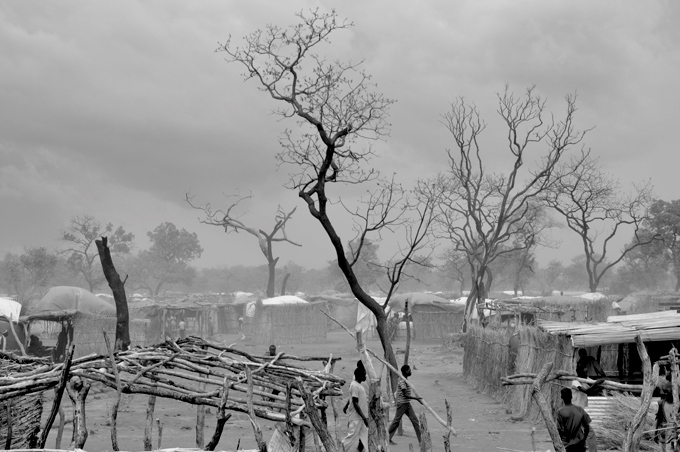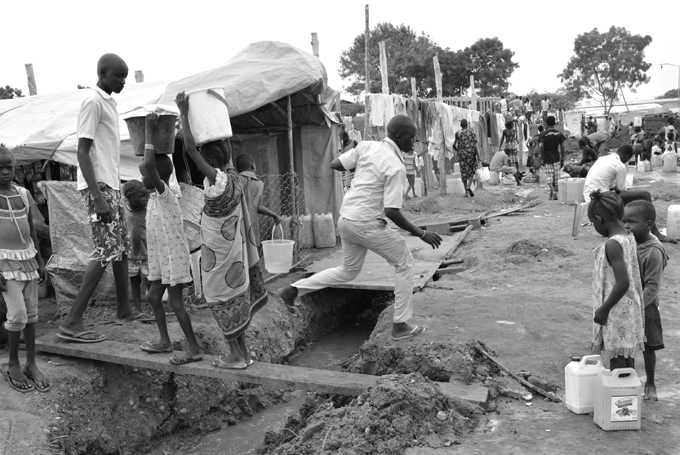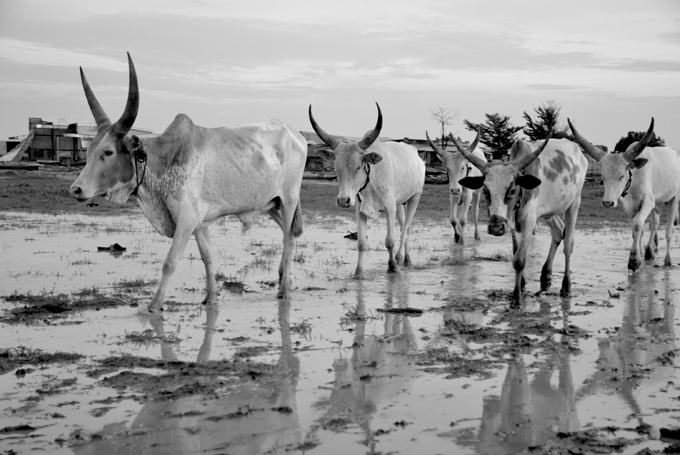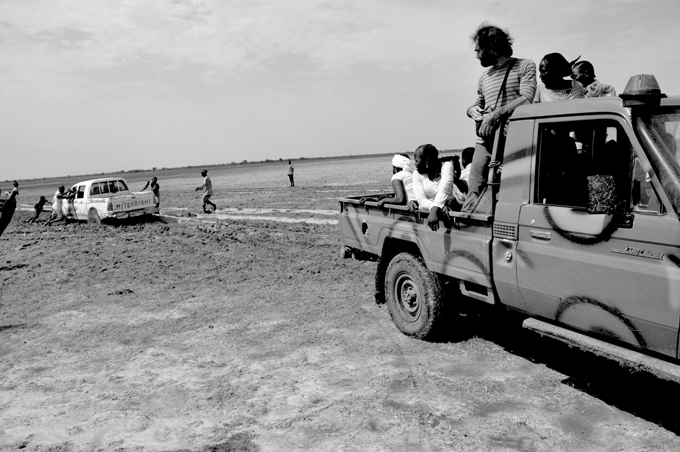February 28, 2015. Chicago, U.S.A.
For months the park below my apartment was a white sheet, the trees pencil drawings on a blank canvas. Winter coats Chicago, and the cold contours everything. Whatever may separate me from the millions who live here, for the long months of winter, we are together, struggling against a wind that makes me feel like I am wading through water. Now though, the snow is beginning to melt, awaking angry patches of red earth. Spring has arrived, and no one is helping anyone else get a car out of the snow. Life is no longer a question of how to bear conditions beyond our control. People’s postures have changed. They walk upright; they can plan again. The city opens up, and with it comes the promise that we can move in space and not simply sit at home, stuck in time.
Sitting in front of this prelude to spring, my morning takes me to South Sudan, where I spend much of my life. The Sudan Tribune is running a story on the United Nations (UN), which is setting up a sanctions program to target the leaders of the groups involved in the civil war. The conflict, which began in December 2013, sets the government of Salva Kiir, the sitting president, against his former vice president, Riek Machar, and his rebel force. A leaked report on the conflict—of dubious authenticity—recommends excluding both men from a future transitional government, which the report proposes should be overseen by the AU and UN. Only four years after the international community congratulated itself on South Sudan’s secession from Sudan, it is having second thoughts. My inbox contains a litany of NGO reports demanding transitional courts and accountability for war crimes. Historians may no longer agree with Thomas Carlyle that “the history of the world is but the biography of great men,” but they certainly didn’t tell the journalists and politicians. Reading the news from afar, one would be forgiven for thinking that the fate of South Sudan depended on the actions of just a few men—21st-century Napoleons—and that life was simply a matter of their intentions, unconstrained by the world around them.
Skype sounds. It is a friend in Juba, South Sudan’s capital, saying hello. I have only one question: How is the weather?

It is about to rain in Yida, South Sudan’s largest refugee camp, 2014. Photo by Jérôme Tubiana.
June 5, 2011. Gokk Machar, Northern Bahr el Ghazal state, South Sudan.
The rains are about to begin. I am walking down Gokk Machar’s central street, the earth clinging to my boots, when a gust of wind heralds their arrival: torrential vertical sheets that sting my eyes and pit the road like machine-gun fire, kicking up muddy shrapnel. Everyone on the street flees. I take cover under the corrugated iron awning of a shop selling cigarettes and sugar. The rain slams into the roof, making conversation impossible. Thrown together, we huddle at the back of the shop, refugees from the weather, and look out dimly through the downpour. Up and down the road the scene is repeated; the whole village crouches in silence, waiting for the rains to stop, waiting for life to begin again.
South Sudan has two lives. The first is waterlogged and still. During the long rainy season, which lasts from June to October, everything stops. The country has precious few miles of paved road, and the dirt tracks that knit it together rapidly become impassable. It is a lean time, a time of hunger. Supplies dwindle, and people hold out for the first harvests of September. Electrical equipment malfunctions, building projects stop, and towns and villages are cut off from the rest of the country. Flooding kills. Yet the rains also bring peace. Roads that were crucial strategic targets during the dry season are deserted, villages are shielded from would-be attackers, and the clashes that punctuate life in South Sudan come to a halt.
South Sudan’s second life is parched, hot and dusty. It is when houses are built and plans are made. Dirt roads become passable: you can visit relatives you haven’t seen for months, and business resumes, as trucks again ply the transport corridors that tentatively connect Juba to the rest of the country. Life is lived faster in the dry season.
Lives are also lost faster. The dry season is when wars are fought. During the long second civil war (1983–2005), which pitted the Sudanese government against the Sudan People’s Liberation Movement/Army (SPLM/A), the government controlled the towns in the south and center of the country, where the SPLA was based. The SPLA, seasoned guerrillas, controlled the rural areas. With the onset of each dry season, the Sudanese army would move out from its urban redoubts, and fighting would begin. Now, in 2015, after South Sudanese independence and the beginning of a new civil war, the SPLA finds itself uncomfortably in the position of the Sudanese government, holding the towns, while the rebel forces are in the bush. The seasons are the bass of the conflict, over which peace negotiations and military clashes play out their solos.
December 29, 2014. Juba, South Sudan.
Finally, he tells me, it’s finished. We are walking next to a stern set of concrete pillars, hot to the touch under an implacable sun. On our left, down a gently sloping hill, are the white-walled glass buildings of the UN’s main base in Juba. It looks like a hospital, clinical and quiet.

The UNMISS Protection of Civilians site in Juba, South Sudan, 2014. Photo by Jérôme Tubiana.
On the other side of the concrete pillars are the civilians that the UN is putatively protecting. In December 2013, after tensions among ruling figures in the SPLM became irreconcilable, government soldiers went house-to-house in Juba, killing civilians suspected of being Nuer, the ethnic group of Riek Machar and much of the rebel movement that was to spring up in the months to follow. Sixteen thousand people fled to the UN compound near the airport, which became a burgeoning camp for the internally displaced. The mandate of the United Nations Mission in South Sudan (UNMISS) includes the protection of civilians, and the civilians interpreted it literally. As clashes broke out all over the country, hundreds of thousands of people came to UN compounds, forcing UNMISS to create what it calls “Protection of Civilians” sites (PoCs). The UN was not prepared for the numbers that arrived. The PoCs were immediately overcrowded, and during the rainy season people slept in inches of water. The camp near the airport is now closed, and the UN has moved its residents to a new camp, two feet from where we are walking.
In such camps, people live suspended lives, as if the rains had come with the conflict and not yet left. Life is reduced to survival, and plans are pushed into a postulated future, which will begin only when the war ends. These camps, which were supposed to be temporary, continue to be needed as the conflict moves into its second year and people still fear for their lives. The South Sudanese government associates the PoCs with the rebels—“Why else would they flee?” one SPLM politician asks me—and on several occasions SPLA soldiers have come to the camps looking for members of Machar’s rebel force. UNMISS staff are afraid that the presence of the PoCs might mean that government forces will attack the peacekeepers as well as the civilians they are supposed to be protecting. The record of UNMISS in South Sudan, like that of the UN mission in Sudan prior to the south’s secession, is one of cowardice and inefficiency. In Abyei and Kadugli in 2011 and in Bentiu and Malakal in 2013–14, civilians were killed just outside UN bases, as the peacekeepers looked on. The UN would rather everyone left the Protection of Civilians sites. Then order would prevail, and it could go back to protecting civilians. Until then, a concrete wall separating the civilians from the busy bureaucrats on the other side will suffice.
We turn away from the concrete pillars and walk down the hill. A patrol passes us, and the UN officer I am accompanying shakes his head in disgust. “Why are we patrolling here?” he says, waving his hand toward the white buildings. There is very far away. There is the pace of village life, measured in rain clouds and the passage of cattle. There are groups of soldiers, sitting under cuei trees, drinking water spoiled with oil. There are people in canoes, heading down rivers swollen with rain, in search of a bag of sorghum. Here the UN is patrolling itself, as if the whole multimillion-dollar peacekeeping operation were devoted primarily to cleansing itself of there.
The enormous country outside these walls enters only when dressed up as a report. If the UN gets out there, it doesn’t stay long. When the roads are impassable, the UNMISS peacekeepers take helicopter flights to investigate the situation on the ground, and the moment the chopper lands, the pilot starts his watch. If the peacekeepers are not back within a couple of hours, the flight leaves. All you can hear in such a short space of time are murmurs. These murmurs are turned into reports that, back in Juba, suddenly acquire solidity, repeated in the echo chamber of the UN’s international staff.
At the meeting I attend, all the talk is of military plans: troop movements and likely sites of conflict. There are maps showing which roads are passable. Highlighted in red are those forbidden to UN personnel. Conflict zones and impassable roads alike are marked as red arteries. You can trace the immobility of the entire organization through these maps.
As I hear the experts talk, there is no trace of how little any of us actually know. The South Sudanese government cut off mobile phone reception in the three states most affected by the conflict (Unity, Upper Nile and Jonglei), and information is incredibly hard to come by, let alone verify. Undeterred, we play games of Risk atop ludicrous maps that misname some villages, entirely miss others and lack any information about the routes of the cattle that are so central to the Dinka and Nuer, South Sudan’s two largest groups, which are both composed primarily of transhumant pastoralists. People who would be hard-pressed to even name all the ethnic groups that live in Upper Nile pass authoritative judgments on the state’s future without blinking. This is the fiction: the military commanders are in control, decisions are known instantly throughout the land and troops move as quickly as emails. It’s game theory without the math.

In Leer, Unity state, South Sudan, 2014. Photo by Jérôme Tubiana.
It’s easy to play game-UN. Here are the rules. Talk with total assurance and feigned intimacy. A lowered voice helps. Cultivate a source out there. The UN is an internal world of curfews and emails. You find its politics not in South Sudan but in New York. If you work for the UN, it can be weeks before you ever have any contact with there, though there is the whole reason that the UN is in the country. The rumor mill, that roulette of war talk, feeds off the secret source. A taxi driver will do. If none are at hand, read a newspaper article, and lower your voice further: “Did you know that…?” Above all, to win at game-UN, don’t criticize the game.
The meeting continues. We talk about the politics of the AU, the joke that is the ongoing negotiation process in Addis Ababa and the evacuation plans that the UN is making. I remember thinking, nobody talks about the weather.
July 6, 2012. On the road to Yida refugee camp, Unity state, South Sudan.
The beginning of South Sudan’s rains signals the start of high season for Chol, proud possessor of Pariang’s only tractor. Demand for his services comes not from the area’s sorghum farmers but from unwilling tourists, their vehicles helplessly stranded along the muddy road leading to town.
In the stark afternoon light the road looks like a photograph of a busy rural thoroughfare. There are around 20 vehicles marooned on a one-mile stretch of mud, just wide enough for two trucks to squeeze past each other. Flat grassland spreads out in all directions, with only the occasional tree to give respite from the heavy, humid heat. In the dry season, transhumant groups move south from Sudan, cross the disputed border—some 40 miles north of Pariang—and graze their cattle here. Before the rains, grass is sparse, and the red earth turns to dust.
The first heavy downpours of the rainy season transform the landscape. In places the grass is so tall that I cannot see over it, and the road has become a mountain range of potholes and ragged ridges left by the heavy wheels of aid trucks.
The people on the road are as immobile as the vehicles next to which they huddle, seeking shelter from the sun. There are World Food Programme trucks, their blue logos covered in mud, trying to get supplies through to Yida, South Sudan’s biggest refugee camp, before the rains render the road totally impassable. They keep aloof company with battered Soviet-era vehicles, taking supplies to Jau, the northernmost military base of the SPLA. My 4×4, which sits waist deep in the swampy grassland at the edge of the road, looks puny in comparison to these stalwarts of the rains. We converge—soldiers, aid trucks and journalists alike—all our plans gone awry.
When the tractor arrives, everyone crowds around Chol. No one wants to spend another night by the side of the road. They argue about who is to be towed first: the SPLA or their northern comrades.

Stuck on the road to Yida, 2014. Photo by Jérôme Tubiana.
Despite the international media’s coverage of South Sudan’s referendum in 2011, which framed its secession from Sudan as a matter of manifest destiny (with the United States in the role of all-powerful midwife), the second civil war was not fought for independence. The SPLM’s vision was of a new Sudan, in which the country’s domination by a Khartoum-based elite would be overturned. Its struggle involved soldiers from Blue Nile and South Kordofan, areas that would not become part of South Sudan and that were offered only dimly defined “popular consultations” in the 2005 peace agreement. Shortly after South Sudan formally declared independence, the SPLA in both states (which would call itself the SPLA-North) went back to war against the Sudanese government. For these soldiers, this civil war is simply a perpetuation of the last.
Eventually, after much shouting, the SPLA’s soldiers move back to their vehicles; it is the SPLA-North’s resupply mission that shall take priority and be towed first.
In Addis Ababa, where the South Sudanese government is negotiating with Sudan, the SPLM insists that the SPLA is not supporting the SPLA-North across the border and has no role in the conflict within Sudan. On the road to Yida, just south of the Sudanese border, things feel very different. I sit with SPLA and SPLA-N soldiers who, a decade previously, had been part of the same rebel force, fighting the same enemy. On that July afternoon, chatting with soldiers who had neither satellite phones nor transportation, stuck in mud that might take weeks to get through, the rhythms of the conflict in South Sudan had little to do with the pronouncements of the politicians and the plans of the UN.
December 26, 2014. Just outside El Toor oil field, Unity state, South Sudan.
The oil depot is a giant children’s playground. There are metal pipes shining out of the red earth, as inviting as slides at the fair. Long staircases take one up along the huge cylinders of oil tanks, now empty. Containers dot the perimeter of the depot, their walls already green after the rains, their floors a patchwork of half-burned documents, the carbonized remnants of life in the oil industry. I flick through the papers: production figures, requests for leave and records of worker complaints about late payment.
The soldiers responsible for guarding the site are one kilometer to the north. As we drive up, the small company assembles under a tree. They have awaited the end of the rainy season and its hunger.
Normally the rains would bring two harvests, but the war has disrupted the agricultural cycle, and since June the soldiers have been without pay, surviving on pumpkins. Salaries also have a seasonal rhythm. Later on the same trip, I encounter soldiers closer to the front lines, who get paid just in time for the fighting.
The commander, his eyes tired, pushes one of his soldiers forward. His arms are swollen. Oil, he says, in the water. We begin to talk. Since early clashes drove the rebel forces north into Sudan and south toward Bentiu, the state capital, this has been a quiet war. For the last six months the soldiers have been waiting, with little food, little ammunition and bad water.
While journalists breathlessly report massacres and political negotiations in Addis Ababa, the conflict’s rhythm unfolds not through events but with the seasons. The international community talks about the importance of distinguishing civilians from soldiers, as if it were somehow evident. The truth? There is no one who does not have a relative on one side or the other, and many of the soldiers I spoke to on my last trip returned to their communities during the first rains for planting and then returned again for harvest. Soldier is merely one of the hats that they wear: to be dusted off and donned again during the dry season, when the South Sudanese landscape will be striated with accidental clashes, waiting troops and frustrated commanders, trying to control a conflict that is always exceeding them.

The heavens will open, 2014. Photo by Jérôme Tubiana.
This piece was made possible by Hivos, an international organization that seeks new solutions to persistent global issues with incisive projects against discrimination, inequality, abuse of power and environmental degradation.


